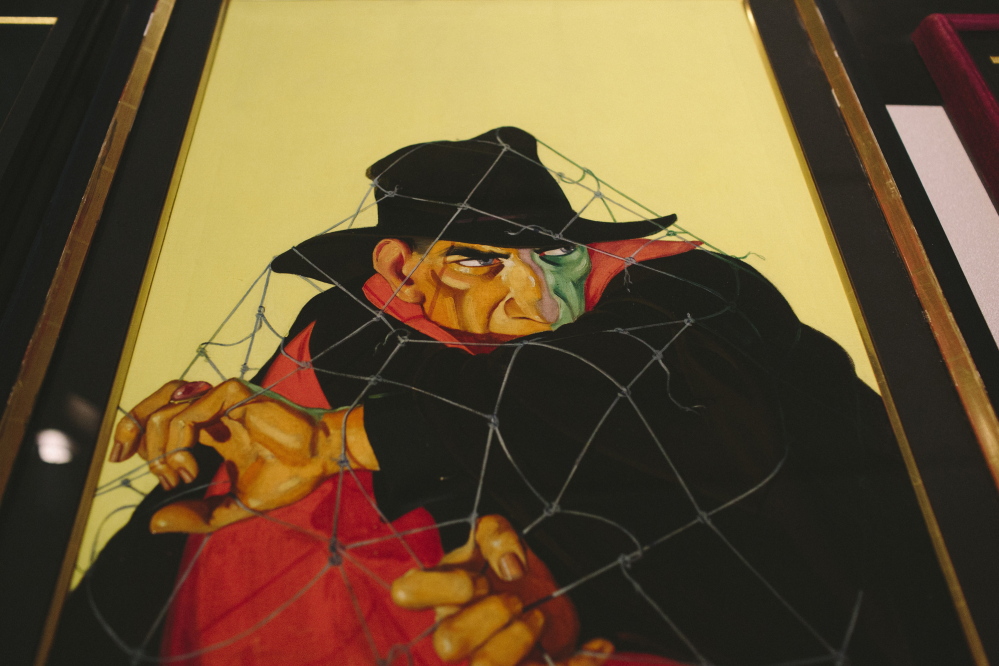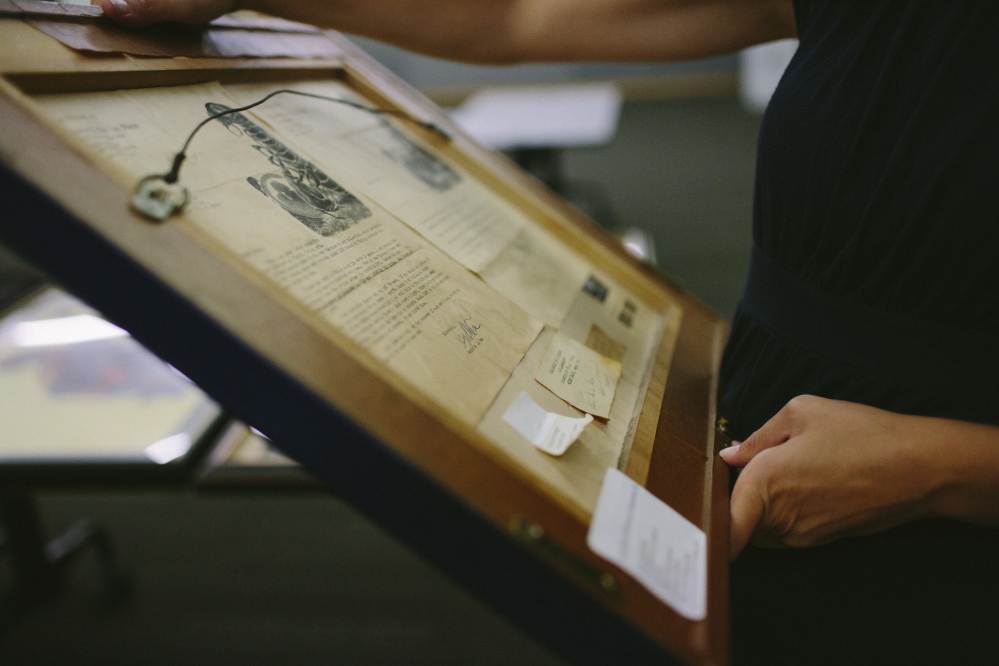Joshua David Bergey connected with the grandfather he never knew through beautiful women and superheroes.
Bergey, a former dean at Maine College of Art now living in Philadelphia, is writing a book about the artist Earle K. Bergey, who made his mark in the world of pulp fiction. He made paintings for the covers of magazines and books, and most famously illustrated the 1948 Anita Loos book “Gentlemen Prefer Blondes.” The illustration is said to have been the basis for casting Marilyn Monroe in the film a few years later.
Beginning this week, the Portland Public Library hosts an exhibition of pulp fiction covers, “The Pulps,” including an alternative version of Earle K. Bergey’s “Gentlemen” painting.
The exhibition opens for Portland’s First Friday Art Walk and will remain on view through Dec. 26. It is culled from a large private collection and offers a look into the sometimes misunderstood and often controversial genre of pop-culture art. It is being shown in conjunction with the illustration department at Maine College of Art.
Pulp fiction – the style of publishing, not the Quentin Tarantino movie – refers to a broad category of books and magazines that were popular with a generation of readers between the world wars. They were printed on cheap paper and considered disposable.
But they were also dramatic, romantic and full of bodice-ripping, gun-blazing action. They were the domain of the Shadow, Tarzan, crafty criminals and the trench-coat-wearing detectives who tried to foil them. They captured the imagination of a youthful American public seeking an inexpensive escape from the realities of the Depression era and the tension associated with the build-up to World War II.
The material ranged from Westerns to romance and science fiction to adventure. The artists were challenged to create daring and often controversial covers that illustrated stories with titles like “Black Pool for Hell Maidens,” “The Room of Doom” and “Viking Invaders!”
From an art perspective, the paintings are notable for their dramatic perspective and compressed composition, said Scott Nash, who chairs the illustration department at MECA.
ILLUSTRATORS FADED AWAY
While many writers who came up through pulp fiction went on to respectable careers in literature – Agatha Christie, Ray Bradbury and Isaac Asimov among them – most of the illustrators remained unknown.
Among those who achieved some recognition were Bergey, Margaret Brundage and Norman Saunders.
Nash said this collection of pulp art is both “unabashedly entertaining” and instructive. While pulp illustration was once considered unworthy of serious treatment in the fine-art world, Nash said time has proven those notions false.
He compared the work of Bergey, Walter Baumhofer and George Rozen and others in the Portland show to widely known and respected artists like N.C. Wyeth, who also illustrated books.
“I’m very excited about exposing some of these artists,” Nash said. “These paintings were literally throw-aways. The companies that reproduced them would toss them to save the cost of storing them. But these artists created a striking narrative in a simple composition.”
With time, the pulp art that survived that era also has become collectible.
This exhibition brings attention to the pulp fiction heyday of the 1930s into the 1950s, said Bergey, who will return to Portland in November to lecture at MECA about his grandfather and “The Pulps.” He’s spent the past 18 years learning about his late grandfather, who died in 1952 long before Bergey was born, and is in the final phase of writing about him.
“There is something to be said about the cultural impact of this work,” Bergey said in a phone interview. “When you look at just one pulp art painting, you feel as if you have seen it before.”
Interest is growing because the generation that read pulp fiction is dying, and nostalgia and intrigue are associated with the passage of time, Bergey said. The pulps speak to a specific moment in America’s cultural life.
“Now that America’s greatest generation is saying its farewell, there is a lot of desire to look back and have a connection to our past, to our families, to our legacies and to the stories we’ve been told,” Bergey said. “Those stories are coming up through people’s attics and basements.”
A DIFFERENT ‘BLONDE’
The exhibition at the Portland library includes about 75 pieces, and it depicts some of America’s best known action heroes and fictional characters, such as Tarzan and the Lone Ranger. They also include alluring women, like the buxom blonde painted by Earle K. Bergey – only the version of “Blonde” that appears in the library exhibition isn’t blonde, she’s a redhead. Instead of drawing the lusting eyes of her male admirers in the more famous painting, the subject in the Portland show faces the accusing pointed fingers of an angry mob, who assume the bloody knife in her hand is a murder weapon.
Bergey made the illustration in the early 1940s for a story called “Doubling in Murder” that appeared in the magazine “Feature Detective Cases.” He used the same template, but with a different woman and background, when he made the painting for “Gentlemen Prefer Blondes” later that decade.
‘STILL RELEVANT’
The paintings on view in Portland are from the collection of Robert Lesser, a New Yorker who amassed the world’s largest collection of pulp art. He donated it last year to the New Britain Museum of American Art in Connecticut.
While pulp fiction has vanished, the spirit of the genre survives in TV shows like “Breaking Bad” and serial crime dramas, Nash said.
“I would argue that pulp fiction is still relevant,” he said. “We don’t call it pulp fiction anymore, but we’re still in the pulp realm. It was escapism, and people watch ‘CSI’ for the same reason they read ‘The Shadow.’ “
Send questions/comments to the editors.






Success. Please wait for the page to reload. If the page does not reload within 5 seconds, please refresh the page.
Enter your email and password to access comments.
Hi, to comment on stories you must . This profile is in addition to your subscription and website login.
Already have a commenting profile? .
Invalid username/password.
Please check your email to confirm and complete your registration.
Only subscribers are eligible to post comments. Please subscribe or login first for digital access. Here’s why.
Use the form below to reset your password. When you've submitted your account email, we will send an email with a reset code.